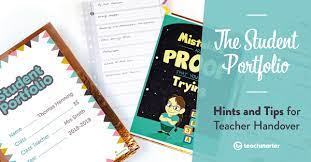Passing a student’s educational torch from one teacher to the next is an essential yet intricate part of the academic journey. To ensure a seamless transition, a well-structured student portfolio is invaluable. Customarily, it showcases the student’s progress, highlights achievements, and features areas that need continued support. Teacher handovers are significantly more effective when portfolios are employed wisely. Here are essential hints and tips to harness the full potential of student portfolios during teacher handovers.
Conciseness is key: Teachers have limited time during transitions; thus, portfolios should be succinct. Include summaries of evaluations, notable work samples, and quick reference sheets for learning styles and needs.
Standardize formats: By adopting a standardized format across grades or subjects, educators can quickly locate information without sifting through unfamiliar layouts.
Celebrate successes: A portfolio should not only be a collection of academic highs but also a reflection of personal growth and overcoming challenges. Document milestones and breakthroughs to provide a full picture of the student’s development.
Track progress towards goals: Clearly outline academic goals set at the beginning of the year and track advancements towards meeting them. This will help the new teacher understand where on their educational path the student currently stands.
Use evidence-based reflections: Including reflections on assessments or projects provides insights into a student’s thought processes. These reflections can be incredibly revealing for incoming educators who want to connect with their new students on a deeper level.
Highlight extracurricular activities: To aid in holistic teaching approaches, make note of students’ extracurricular interests and talents. This helps teachers to form stronger bonds with their students by recognizing them as individuals beyond their academic life.
Incorporate peer and self-assessments: It’s vital to involve the students in their own learning process. Encourage them to reflect on their performance with guided peer reviews and self-assessment prompts that can be passed along to the next teacher.
Digital portfolios: Where possible, use digital platforms for creating portfolios. They offer ease of transfer, multimedia integration (such as video presentations or audio recordings), and collaborative features that allow continuous updates.
Implementing these strategies will not only ease the transition for incoming teachers but will also empower students by honoring their journey with respect and continuity from year to year. Demonstrate this value by crafting a portfolio that tells each student’s unique story – academically, personally, and socially – giving their future teachers a strong foundation upon which to build a successful year ahead.





